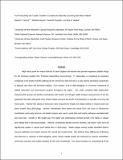Fish Productivity and Trophic Transfer in Created and Naturally Occurring Salt Marsh Habitat
Author(s)
Dionne, Michele; Burdick, David M.; Hobbie, Erik A.; Vincent, Robert
Download12237_2015_9969_ReferencePDF.pdf (1.097Mb)
PUBLISHER_POLICY
Publisher Policy
Article is made available in accordance with the publisher's policy and may be subject to US copyright law. Please refer to the publisher's site for terms of use.
Terms of use
Metadata
Show full item recordAbstract
High marsh pools are natural features in New England salt marshes that provide important subtidal refuge for the dominant resident fish, Fundulus heteroclitus (mummichog). F. heteroclitus is considered an important component in the trophic transfer pathway for its omnivorous diet and role as a prey species providing connectivity to adjacent near-shore and terrestrial habitats. Pool creation, such as ditch-plugging, is a common component of habitat restoration and enhancement projects throughout the region. Our study combined field experiments measuring fish growth and benthic invertebrates with carbon and nitrogen stable isotopes measurements to test the hypothesis that ditch plug pools have similar trophic structure and levels of productivity as naturally occurring salt marsh pools. Marked fish placed in enclosures were measured for length and weight weekly in natural pools and pools created using ditch plugs. Benthic invertebrates were sieved and sorted from soil cores to characterize invertebrate community structure, and stable isotopes were used to posit diets and trophic pathways associated with each pool type. Growth in fish length was 27 % higher and instantaneous biomass growth 17 % higher in natural pool habitat than in ditch plug habitat. Likewise, invertebrate species richness, biomass, and caloric value were all significantly greater in natural pool habitat than in ditch plugs. Stable isotope mixing models identified distinct resource utilization and trophic structure for natural and created pools. We attribute these differences to flooding and plant loss in response to ditch-plugging, which reduces habitat quality (as measured by resource availability, community structure, and trophic transfer) for fish and invertebrates. Our study increases our understanding of the ecology of salt marsh pools, and the significant results indicate that pools created using ditch plugs do not replicate the structure and function of natural pools at Moody Marsh.
Date issued
2015-05Department
Massachusetts Institute of Technology. Sea Grant College ProgramJournal
Estuaries and Coasts
Publisher
Springer US
Citation
Vincent, Robert E. et al. “Fish Productivity and Trophic Transfer in Created and Naturally Occurring Salt Marsh Habitat.” Estuaries and Coasts 38.4 (2015): 1233–1250.
Version: Author's final manuscript
ISSN
1559-2723
1559-2731